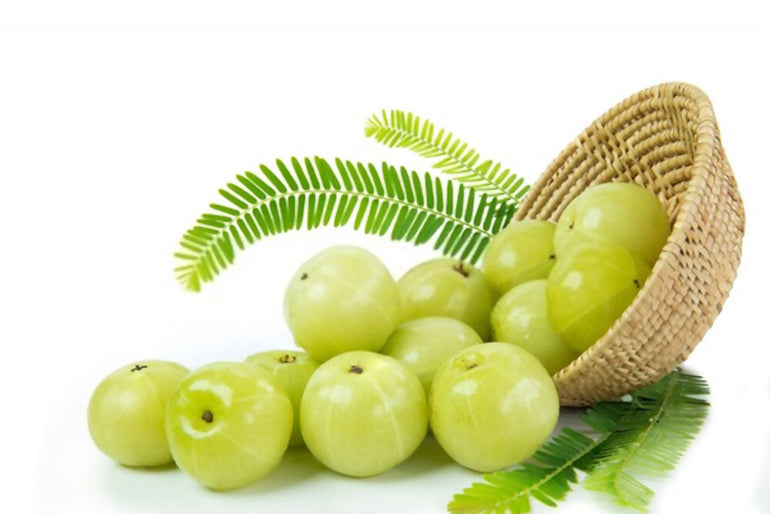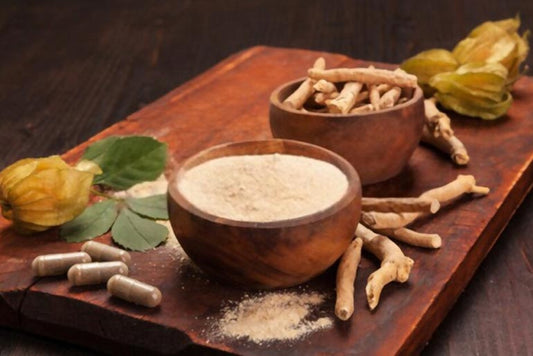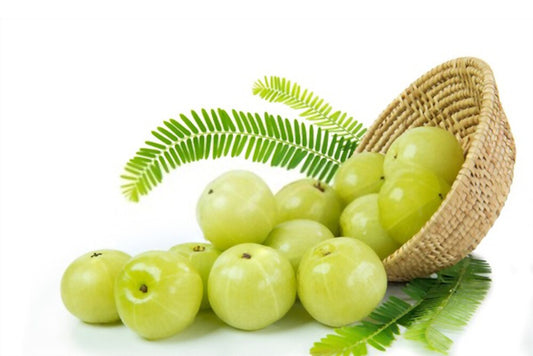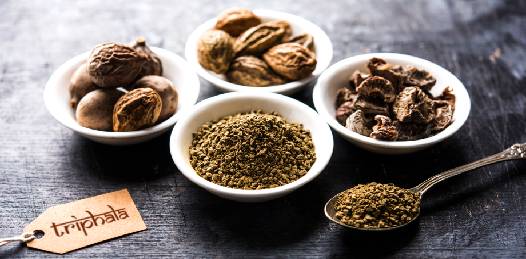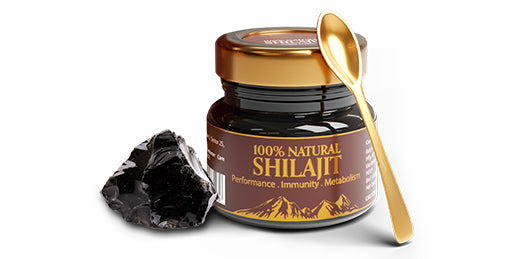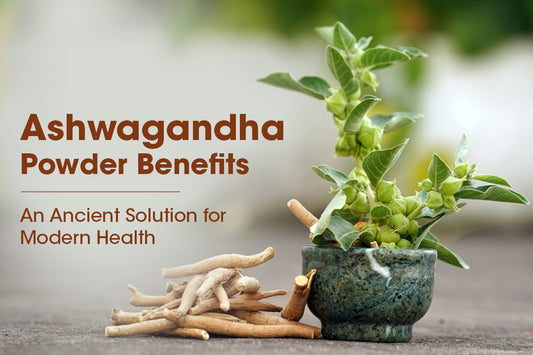Amla is a common Ayurvedic ingredient used as food and medicine in India. It is abundantly available in the market in the months between October to February and is relished in the form of pickles, chutneys and candies. Besides its uses in the kitchen, Amla is an important ingredient in Ayurvedic formulations. Some common formulations like the Chyavanaprash and Triphala contain Amla as the main ingredient.
Common names of Amla
Amla is found all over the country and hence known with different vernacular names based on the regional languages.
- English - Indian Gooseberry
- Hindi - Amla/ Aonla
- Sanskrit - Amalaki
- Punjabi - Aamla, Ambul
- Gujarati - Avla, Avlam, Amli
- Bengali - Aamro, Aamla
- Marathi - Avalkatti, Avla
- Malayalam- Nelli, Nellikkaya
- Tamil - Nellikkai
- Kannada -Nelli Kayi, Bettada nellikayi
- Telugu - Usirikai, Usiri
Taste, Ayurvedic properties and Actions of gooseberry:
Taste: Amla has a predominantly sour taste followed by astringent, bitterness, pungency and sweetness. It is known to consist of all tastes except the salty.
Properties: It is cold in potency and causes dryness.
Actions: Due to sour and sweet tastes, it reduces vata, cooling nature reduces pitta, and due to its bitter, astringent taste and drying property, it reduces Kapha.
Chemical composition
Vitamin C (Ascorbic acid) in Amla:
One serving of Amla contains about 600mg of Vitamin C, which is twenty times the Vitamin C present in Oranges. It is a water-soluble vitamin and is essential for the growth, development and repair of all tissues.
Apart from this, Indian gooseberry also contains phytochemicals such as mucic acid, gallic acid, emblicanin A and B, Phyllemblin, quercetin and ellagic acid.
Phyllemblin found in the fruit pulp is said to be beneficial for the nervous system. The tannins present in Amla, like emblicanin A and B, have high antioxidant activity.
Hence, in this context, it would be correct to say, "An Amla a day keeps the doctor away."
The ORAC score of Amla is 261500 μ mol TE/100g. The ORAC (Oxygen Radical Absorbance Capacity) unit, ORAC value, or "ORAC score", is a method of measuring the in vitro antioxidant capacity of different foods and supplements. The higher the ORAC score, the more is the resistance of the substance to resist oxidation.
Indian gooseberries are one of the highest antioxidant food in the world. Like the "Ribes uva-crispa", the gooseberry varieties found outside India have the ORAC score of 3332, which is less than the Indian gooseberries.
Nutritional value
Indian gooseberry is called the superfruit for a reason. Here is Amla's nutritional value per 100g:
- Energy - 96KCal
- Carbohydrates- 6.9 gm
- Iron - 1.2 gm
- Protein- 0.9 gm
- Fat - 0.1 gm
- Fiber - 3.4 gm
It is also a rich source of calcium, phosphorus, magnesium, Vitamin B complex and sodium.
How to take Amla?
- Amla can be taken internally in the form of raw, cooked or dry forms. Taking 1 or 2 fresh amlas per day is considered beneficial.
- Amla Powder (churna) dosage is 3-6 gms per day and has to be taken with warm water.
- Amla syrup/ undiluted fresh juice of Amla can be taken in the dosage of 10-20 ml per day regularly.
Amla with milk:
Amla has a predominant sour taste and never should be taken with milk. The acidic content in Amla curdles the milk and causes indigestion. Some preparations of Amla like Chyavanaprash or Amalaki Rasayana is advised to be taken with milk as an adjuvant. These formulations consist of honey and sugar candy which is predominantly sweet. Milk, in this case, is said to compliment the benefits of Amla.
Benefits of Amla for various disorders:
Amla for diabetes and its complications:
Amla is indicated to be consumed in diabetes and all types of obstinate urinary disorders. Researchers found that taking Amla significantly reduced fasting, postprandial blood sugars and lipid levels in subjects with Type 2 diabetes.
Amla can be taken in the form of fresh juice, powder or in Ayurvedic formulations such as Nishaamalaki churnam, Triphala churnam etc.
Consumption of Amla also reduced the effect of diabetic complications such as neuropathy, nephropathy and retinopathy. Gooseberry has disease-modifying qualities and is known to improve the symptoms of blurred vision, pain and burning sensation in the hands and feet. Amla also reduces the symptoms of excessive thirst, hunger and fatigue associated with diabetes.
Is amla powder good for hair?
Amla, when taken internally or applied externally, reduces hair fall and greying of hair. The tannins give a thick, lush, black hair when taken with Bhringraj powder.
- A mixture of Amla and Bhringraj powder can be applied over the scalp and hair as a deep herbal conditioner mixed with sesame oil. Wash this hair pack once it dries.
- Applying amla powder mixed with lemon juice on the hair and scalp cures dandruff and hair fall.
- For dry and rough hair, amla powder can be mixed with sesame or coconut oil and washed after 20 minutes. This also reduces premature greying of hair.
- Triphala is an Ayurvedic formulation containing Amla that can be used on the bald patches on the scalp. Triphala powder is burnt on an iron vessel, and this is applied to the affected areas mixed with coconut or sesame oil. Thus, Amla is a sure shot remedy for alopecia aerata.
The Ayurveda Co. Methi Bhringraj and Amla Hair Care range contains the goodness of Amla. They prevent hair fall, reduce frizz and control dandruff.
Apply the Methi Bhringraj and Amla oil for hair and massage onto the scalp and whole length of the hair for 10-15 mins.
Rinse with Methi Bhringraj and Amla shampoo, which is absolutely free of sulphates and parabens.
Use the Methi Bhringraj and Amla Hair mask once a week onto the scalp for deep conditioning of the hair.
Amla for Eye problems:
Amla powder is used to treat vision problems, infections such as conjunctivitis, stye and blurred vision. Amla or Triphala powder can be consumed with honey every night to cure eye-related problems.
Amla for skin:
The antioxidants in Amla is known to delay ageing and to give healthy glowing skin. Formulations made with Amla are given to cure various skin diseases.
Amla powder consumed with turmeric, saffron strands, or manjishta helps to cure skin ailments.
Some Ayurvedic formulations like Nalpamaradi tailam used on the skin also contain Amla as of the ingredients. The Ayurveda Co Nalpamaradi curcumin with 2% Natural Retinol Night cream contains the goodness of Amla and can be used regularly.
Massaging the body and face with Eladi Triphala face and body glow oil gives a shine to the skin. This can be done after exfoliating with Eladi Triphala body and face polisher.
Applying face serum with Triphala, yashtimadhu and 10%Niacinamide for face r educes pore size, making the skin look polished & glass-like. It also gives the skin a tighter, firmer appearance.
Dosha based consumption of Amla:
Amla fruits are known to balance Vata, Pitta and Kapha doshas in the body. However, here is how you should be taking Amla to suit your Prakriti (body constitution).
Amla to balance Vata dosha:
For a person with Vata Prakriti or vata disorder, Amla can be taken with sesame oil.
- Amla fruit pulp can be fried in sesame oil along with some vata reducing spices like fenugreek and asafoetida added with salt. This preparation being predominant of sour and salty taste, reduces vata dosha.
- Another way is to add sesame oil with powdered Amla and store it in an airtight glass container. Take 1/2 to 1 tsp of this mixture regularly.
Amla to balance Pitta dosha:
For a person with Pitta Prakriti or pitta disorder, Amla can be taken with ghee.
- Mix powdered Amla with ghee and store it in an airtight glass jar and take this mixture 1/2 to 1 tsp daily to alleviate pitta disorders. Taking the mixture of ghee with amla powder may result in weight gain. Hence it is important to take in controlled doses if you are not looking for weight gain.
- Amla can also be taken with sugar or coconut to reduce pitta dosha in the body.
Amla to balance Pitta dosha:
For a person with Kapha prakriti or kapha disorder, Amla can be taken with honey.
- Fresh amla fruits preserved in honey is a good choice.
- Amla powder can also be preserved in honey, and 1/2 - 1 tsp of this mixture can be taken once or twice a day.
- Fresh amla juice mixed with a tsp of honey is also a good way of taking Amla for Kapha dosha.
This remedy can also be followed by obese persons to increase metabolism and lose weight.
Home remedies with Amla:
- The juice of Amla with Aloe vera cures heartburn and indigestion.
- Amla pulp, mixed with yogurt and honey can be applied over the face and neck to improve skin tone. It also removes suntan.
- Soak cut pieces of 1 amla in a glass of water and drink after 3-4 hours to cure acidity naturally.
- Amla powder consumed with honey regularly cures anaemia.
- Applying hair oil infused with Amla, hibiscus and curry leaves regularly cures hair fall, premature greying, and makes the hair smooth.
- Apply Amla juice on the black spots on the face to fade it gradually.
- Fresh juice of Amla, when taken with honey promotes weight loss. This has to be taken every morning, followed by a low calorie and nutritious diet.
- Amla powder mixed with ghee taken regularly promotes weight gain. A cup of warm water should be taken along with it to digest the mixture.
Formulations with Amla
Triphala: Triphala is a mixture of three fruits, namely Hareetaki (Terminallia chebula), Vibheetaki (Terminallia bellerica) and Amalaki (Phyllanthus embilica). Indian gooseberry is an essential component of Triphala and is added in a ratio equal to other ingredients.
Amla is a cooling herb in the formulation of Triphala, and it balances the formulation. The presence of Amla also makes Triphala useful in eye disorders, diabetes and hair problems.
Chyavanaprash: Chyavanaprash is an Ayurvedic medicine that is well known to all. The divine physicians called the Ashwini Kumaras administered Chyavanaprash to Chyavana Rishi to rejuvenate and make him young.
Chyavanaprash is made up of 500 amla fruit pulp along with about 30 other herbs. This makes Chyavanaprash the best choice for digestive and respiratory disorders. Chyavanaprash also improves immunity and helps your body fight against pollution. 1 tsp of Chyavanaprash can be taken with milk before sleep.
Nishaamalaki churnam: This ayurvedic powder is a mixture of Amla and turmeric. It is potent medicine for diabetes and urinary disorders. 3-6 gms of Nishaamalaki churnam can be taken once or twice a day with warm water. One can prepare this medicine at home and take it regularly.
Amla regulates glucose metabolism.
Bhringamalakadi tailam: It is used for head massage and also can be used as regular hair oil. The base oil is sesame oil, infused with Amla, bhringraj, yashtimadhu and cow milk.
When applied to the head, this oil relieves stress, hair fall, baldness and reduces eye strain. Using this oil also gives a cooling sensation to the eyes.
How to add Amla to your daily diet?
It is very easy to get all the health benefits of Amla by incorporating it into your diet. Here are some easy ways how you can do it.
Recipe 1: Amla chutney to get a daily dose of Vitamin C
Ingredients:
- Amla - 3 big, deseeded
- Coconut - 2 tsp
- Mint leaves - 2 or 3 sprigs
- Ginger - 1-inch piece
- Black Pepper - 1/2 tsp
- Pink salt - as required.
Recipe:
- Coarse grind all the ingredients, and then add salt to taste.
- Serve with hot rice, roti or even idli or dosas.
Benefits:
- It is the best accompaniment for people suffering from acidity and gastritis.
- Adding a teaspoonful of this chutney will help you get the required amount of Vitamin C needed for your body.
Recipe 2: Amla coconut curry to balance Vata, pitta and Kapha
Ingredients:
- Curd/buttermilk - 1/2 cup
To grind:
- Amla - 3 big, deseeded
- Coconut - 2 tsp
- Ginger - 1-inch piece
- Black Pepper - 1/2 tsp
To Temper:
- Oil - 2 tsp
- Mustard seeds - 1/2 tsp
- Cumin seeds - 1/2 tsp
- Curry leaves - 2 sprigs
Recipe:
- Grind the ingredients like Amla, coconut, ginger and pepper by adding water until it becomes a fine paste.
- Heat a pan, add oil and temper with mustard seeds, cumin and curry leaves.
- Add the ground paste to the pan along with some salt and water for a curry-like consistency.
- Switch off the flame once it starts to boil. Add curd or buttermilk and serve with hot rice.
Benefits:
- Amla coconut curry is a very light, easily digestible curry for toddlers and elders as well.
- It is the best curry to relieve fatigue, gum diseases, acidity and heartburn.
- It is a tridosha balancing recipe and hence can restore the general health of an individual.
Recipe 3: Amla Pickles - A digestive stimulant
Ingredients:
- Amla - 15 numbers
- Fenugreek powder - 1/2 tsp
- Sesame Oil- 5tbsp
- Turmeric powder - 1/2 tsp
- Asafoetida- 1/4 tsp
- Red chilli powder - 2 tbsp
- Garlic pods - 6 numbers
- Salt - 1 tsp
Recipe:
- Wash and steam the gooseberries. Deseed and keep them aside.
- In a pan, add oil and when it gets heated, add garlic. Let it fry for a minute.
- Then add fenugreek powder, turmeric powder, asafoetida, red chilli powder.
- Add this spiced oil mixture to the amlas along with some salt. Mix well and store in an airtight container.
Benefits:
- It gives daily dose of vitamin C.
- Amla being sour itself, gives the punch. No need of adding vinegar to the recipe.
- It is a digestive stimulant and treats anorexia.
Recipe 4: Gooseberry preserve / Jam - Sweet treat with Amla
Ingredients:
- Amla - 1 cup grated
- Jaggery - 1 cup
- Water - 1 cup
- Rose essence - 2-3 drops
- Saffron strands - 5-6
Recipe:
- Take a thick bottomed pan. Make jaggery syrup to 2 string consistency.
- Add the grated gooseberry and cook for 4-5 minutes. Switch off the flame when the Amla gets cooked well. Add saffron strands and rose essence. Store in a clean airtight container.
Benefits:
Switch to preservative-free Vitamin C rich gooseberry jams to conserve your health.
Recipe 5: Amla juice
Ingredients:
- Amla -2, deseeded
- Aloe vera pulp - 2 tsp
- Cardamom -1
- Water - 200 ml
- Honey -1 tsp
Grind all the ingredients, strain the juice and add honey. Serve immediately.
Amla juice benefits can be seen when you take it regularly.
Benefits of Amla juice:
- The benefits of drinking Amla juice every day is uncountable. It is beneficial for hair, skin, nails and general health.
- Have a glass of amla juice if you have acidity, gas or bloating problem.
- Amla juice is rich in Vitamin C and cures gums and tooth-related problems.
- Amla helps dandruff, skin diseases of the scalp and hair fall.
- Drinking amla juice every day improves nail growth and shine.
- Improves immunity, prevents infections and inflammatory conditions.
- Improves heart, liver and kidney health.
Recipe 6: Amla murabba
Amla murabba are sweet treats that everyone can indulge in after a meal.
Ingredients:
- Amla - 20 deseeded and cut into four.
- Sugar - 1 cup
- Cardamom - 2
- Water - 1 cups
First, make a sugar syrup and add cardamom to it.
Add cut pieces of Amla to this mixture. You can store this in an airtight jar and take 1 or 2 pieces daily. Or you can also sundry it and take it as a dry amla candy.
Benefits:
- Relieves digestive troubles
- Boosts immunity
- Slows down ageing
- Good to treat anaemia
- A sweet way to enjoy the benefits of eating Amla.
How to store Amla for a long time?
Fresh amla fruits are not available throughout the year. Gooseberries are only available fresh from October to February. Amla juices available throughout the year in the market are added with preservatives. Here are some ways to preserve Amla at your home to use it throughout the year.
- Amla powder can be made from dried amla fruits and stored for up to six months.
- Amla murabba/ pickles and jams also can be stored in the refrigerator for up to a year. Use a clean spoon and store in airtight jars.
- Amlas can be stored in a saturated brine solution for up to a year.
- Sundried amlas can be added with salt and can be stored in clear containers.
- Amlas can be stored in honey for a long time.
Qualities of amla seed:
- Amla seeds are rich in vitamin C, amino acids, tannins and antioxidants.
- Amla seeds are coolant and can be used both internally and externally. These seeds serve the purpose of taking fresh amlas too.
- Roast and grind the seeds to a fine powder and store them in an airtight glass container. This powder can be used for up to six months.
Uses of Amla seed powder:
- Make a paste of gooseberry seed powder with curd and apply it to your hair and scalp once a week. Rinse with water after 20 minutes. The tannins in the powder help prevent premature greying and hair fall.
- 1/2 tsp of Amla seed powder can be taken with warm water regularly to boost your immunity.
- Take Amla seed powder mixed with a glass of warm water before meals to improve digestion. This also relieves constipation.
- Amla seed powder can be sprinkled over soups if you have acidity and gastric problems.
- Amla has anti-inflammatory properties. The seeds can be soaked in water overnight, and the water can be taken in the morning. This helps to manage inflammatory diseases of the gut, joints and PCOD.
Amla wood for water purification
In Kerala, there is an age-old practice of immersing Wooden rings made of Amla into the well. These rings purify the well water and even remove microbes to make it safe for drinking.
In summers, these rings give a cooling property to the well water.
What happens when you take Amla daily?
Amla is a rejuvenating herb, and Ayurveda uses all parts of the Amla tree to formulate various medicines. The fruits, bark, root and leaves are all helpful in treating various illnesses. Taking Amla every day regulates digestion and metabolism, blood sugar levels and even delays ageing. Amla is known to improve the longevity of an individual. There are references in Ayurvedic texts and other ancient texts where some people survived on Amla fruits, milk and some herbs to improve their lifespan.
You will notice a reduction in hair fall and greying of hair, glowing skin, stabilized weight and blood sugar levels, improved digestive health once you start taking Amla regularly.
Now you know the benefits of Amla, reap all the benefits of this fruit by adding it to your daily diet. And remember, "An Amla a day keeps the doctor away."





